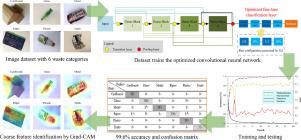Resources, Conservation and Recycling ( IF 13.2 ) Pub Date : 2020-09-08 , DOI: 10.1016/j.resconrec.2020.105132 Wei-Lung Mao , Wei-Chun Chen , Chien-Tsung Wang , Yu-Hao Lin

|
An automatic classification robot based on effective image recognition could help reduce huge labors of recycling tasks. Convolutional neural network (CNN) model, such as DenseNet121, improved the traditional image recognition technology and was the currently dominant approach to image recognition. A famous benchmark dataset, i.e., TrashNet, comprised of a total of 2527 images with six different waste categories was used to evaluate the CNNs’ performance. To enhance the accuracy of waste classification driven by CNNs, the data augmentation method could be adopted to do so, but fine-tuning optimally hyper-parameters of CNN's fully-connected-layer was never used. Therefore, besides data augmentation, this study aims to utilize a genetic algorithm (GA) to optimize the fully-connected-layer of DenseNet121 for improving the classification accuracy of DenseNet121 on TrashNet and proposes the optimized DenseNet121.
The results show that the optimized DenseNet121 achieved the highest accuracy of 99.6%, when compared with other studies’ CNNs. The data augmentation could perform higher efficiency on accuracy improvement of image classification than optimizing fully-connected-layer of DenseNet121 for TrashNet. To replace the function of the original classifier of DenseNet121 with fully-connected-layer can improve DenseNet121’s performance. The optimized DenseNet121 further improved the accuracy and demonstrated the efficiency of using GA to optimize the neuron number and the dropout rate of fully-connected-layer. Gradient-weighted class activation mapping helped highlight the coarse features of the waste image and provide additional insight into the explainability of optimized DenseNet121.
中文翻译:

使用优化的卷积神经网络对废物分类
基于有效图像识别的自动分类机器人可以帮助减少回收任务的繁重工作。卷积神经网络(CNN)模型,例如DenseNet121,改进了传统的图像识别技术,并且是当前图像识别的主要方法。著名的基准数据集,即TrashNet,由总共2527张图像和六种不同的废物类别组成,用于评估CNN的性能。为了提高CNN驱动的废物分类的准确性,可以采用数据增强方法来实现,但是从未使用过微调CNN全连接层的最佳超参数。因此,除了数据扩充外,
结果表明,与其他研究的CNN相比,优化的DenseNet121达到了99.6%的最高准确性。与针对TrashNet优化DenseNet121的全连接层相比,数据增强可以在提高图像分类的准确性上实现更高的效率。用全连接层替换DenseNet121原始分类器的功能可以提高DenseNet121的性能。优化的DenseNet121进一步提高了准确性,并证明了使用GA优化神经元数量和全连接层的丢失率的效率。梯度加权的类激活映射有助于突出显示废物图像的粗略特征,并提供对优化DenseNet121可解释性的更多了解。



























 京公网安备 11010802027423号
京公网安备 11010802027423号